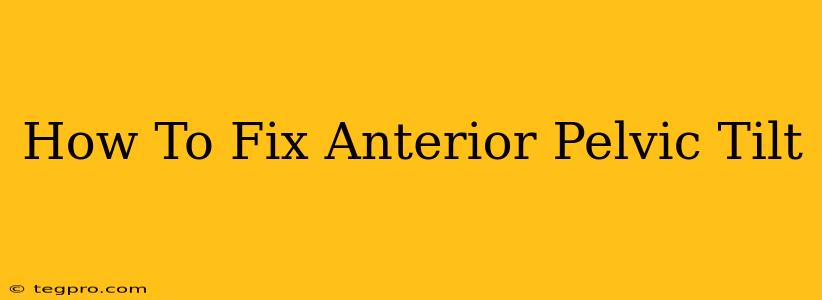Anterior pelvic tilt (APT) is a postural condition where your pelvis rotates forward, causing an increased curvature in your lower back (lordosis). This can lead to lower back pain, hip pain, and even limited mobility. Fortunately, with consistent effort, you can significantly improve and even correct APT. This comprehensive guide will explore the causes, symptoms, and most importantly, the effective solutions for fixing anterior pelvic tilt.
Understanding Anterior Pelvic Tilt
Before diving into solutions, let's understand what causes APT. Several factors contribute, including:
- Weak Core Muscles: A weakened core, particularly the abdominal muscles and gluteal muscles (buttocks), fails to adequately stabilize the pelvis, allowing it to tilt forward.
- Tight Hip Flexors: Tight hip flexor muscles pull the pelvis forward, contributing to the tilt. These muscles are located at the front of your hips.
- Tight Lower Back Muscles: Similarly, overly tight lower back muscles can exacerbate the forward rotation of the pelvis.
- Prolonged Sitting: Spending extended periods sitting can shorten the hip flexors and weaken the core and glutes, creating the perfect storm for APT.
- Improper Lifting Techniques: Incorrect lifting techniques put undue stress on the lower back and pelvis, potentially leading to APT.
- High Heels: Wearing high heels alters your posture and can contribute to APT over time.
Recognizing the Symptoms of Anterior Pelvic Tilt
Recognizing APT is crucial for timely intervention. Common symptoms include:
- Lower Back Pain: This is often the most prominent symptom.
- Hip Pain: Tight hip flexors can cause discomfort in the hip area.
- Increased Lower Back Curve (Lordosis): A noticeable inward curve in the lower back.
- Protruding Abdomen: The abdomen may appear more prominent due to the pelvic tilt.
- Limited Hip Mobility: You may experience restricted movement in your hips.
How to Fix Anterior Pelvic Tilt: Effective Strategies
Addressing APT requires a multi-pronged approach focusing on strengthening weak muscles and stretching tight ones. Here's a detailed plan:
1. Stretching Tight Muscles:
- Hip Flexor Stretches: Perform stretches like the kneeling hip flexor stretch, standing hip flexor stretch, and the pigeon pose (yoga). Hold each stretch for at least 30 seconds.
- Lower Back Stretches: Gentle stretches like cat-cow (yoga), child's pose (yoga), and spinal twists can help alleviate tightness in the lower back.
- Hamstring Stretches: Tight hamstrings can contribute to APT, so incorporate hamstring stretches into your routine.
2. Strengthening Weak Muscles:
- Glute Bridges: This exercise strengthens the gluteal muscles, essential for pelvic stability.
- Plank: Plank variations (standard plank, forearm plank, side plank) target the core muscles, providing crucial support for the pelvis.
- Deadlifts (with proper form): Deadlifts are excellent for strengthening the posterior chain, including the glutes and hamstrings. Consult a professional to ensure proper form to prevent injury.
- Bird-Dog: This exercise engages the core and improves stability.
- Reverse Crunches: These target the lower abdominal muscles.
3. Lifestyle Modifications:
- Improve Posture: Be mindful of your posture throughout the day. Sit up straight, avoiding slouching.
- Reduce Sitting Time: Take regular breaks from sitting and incorporate movement into your day.
- Wear Comfortable Shoes: Avoid high heels as much as possible.
- Proper Lifting Techniques: Always bend your knees and lift with your legs, not your back.
4. Professional Guidance:
Consider consulting with a physical therapist or other healthcare professional. They can assess your specific condition, provide personalized exercises, and address any underlying issues contributing to your APT.
Maintaining Your Progress:
Consistency is key. Regularly perform the stretches and exercises to maintain your progress and prevent APT from returning. Listen to your body, and don't push yourself too hard, especially when starting. Remember, fixing anterior pelvic tilt is a journey, not a race. With dedication and the right approach, you can significantly improve your posture, reduce pain, and enhance your overall well-being.

